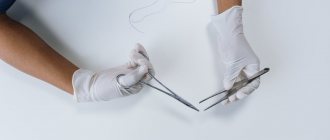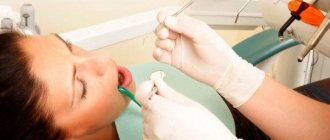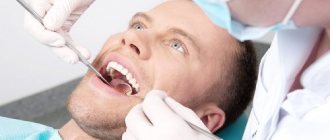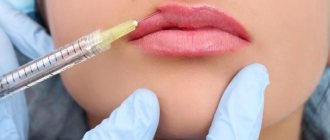Content:
- Why is the wound sutured after pulling out the figure eight?
- Classification of seams
- How long do you need to walk with non-absorbable sutures?
- How long does it take for self-absorbable sutures to dissolve?
- What complications can you encounter after suturing?
- Recommendations for patients
A dental surgeon applies sutures after removing a wisdom tooth if the intervention was very complex and serious injury to the gums occurred.
Often, specialists insist on suturing a wound, even if it is small, in order to minimize the likelihood of infection. Let's consider what material doctors use when suturing after tooth extraction, whether it needs to be removed in the future, and how to properly care for the injured area.
What types of sutures are distinguished in dental implantology?
Sutures after bone grafting and sinus lifting are usually used of 3 types:
- Monotypic or single;
- Supporters;
- Continuous.
Single sutures are not recommended if the lingual and vestibular flaps are located at different levels. The thread ends are tied so that the knot is located close to the buccal surface of the alveolar process. As a result, this makes it easier to remove sutures in the future and is a preventive method for possible tongue injuries. Especially for those threads that have hard and traumatic ends.
A supporting suture is used in cases where there is a limitation for surgical intervention, and cutting occurs exclusively on the vestibular or lingual flap.
A continuous suture is used in the area of several teeth, when all the flaps must move in the apical direction. As a result, the cheek flap is fixed along its entire length. From the inner edge, the entire procedure is repeated, but with a lingual flap. The knot is tied in the same place where the seam was originally.
Why is the wound sutured after pulling out the figure eight?
Wisdom teeth are very insidious and often lead to serious problems. Pulling it out most often resembles an operation. Since the roots of the unit go deep into the gum and can be ornate, tortuous, soft tissue is often excised to extract them. After all solid debris has been removed from the depths of the tissue, the wound is sutured. This is done in order to:
- prevent bleeding;
- protect the blood clot formed in the wound from injury;
- protect the operated area from the accumulation of food debris;
- minimize the risk of damage to the operating area;
- speed up regeneration processes.
It is believed that applying sutures after wisdom tooth removal reduces the likelihood of infection by approximately 90%. This is explained by the fact that pathogens cannot penetrate into the deep layers of the wound.
Why are sutures needed after wisdom tooth removal?
Removal or in medical terms “extraction of third molars” is a complex operation that should be performed not just by dentists, but by specialists in the field of surgery. If the tooth has not yet completely crawled out, but is already interfering with your life, then to remove it you will need to cut the gum.
This is a full surgical procedure performed under anesthesia. Of course, in order to remove the “figure-of-eight”, you will need to cut the tissue, and this leads to the subsequent application of sutures. Sutures promote rapid tissue healing, help cope with the loss of blood clots, and avoid infection.
Classification of seams
After tearing out the “eight”, at the discretion of the dental surgeon, regular and self-absorbing sutures can be applied.
In the first case, we are talking about materials that cannot dissolve on their own. These are silk, nylon, polyester. Such threads are not absorbed. They securely hold the edges of the wound until the doctor removes them. Self-absorbable material is absorbable. Its main advantage is that the patient does not have to visit the doctor again to have his stitches removed. The latter disappear without a trace on their own.
There are two types of self-absorbable threads:
- Absorbable due to hydrolysis reaction. These include Dexon and Vicryl threads. They are synthetic and do not cause allergic reactions. The edges of the wound are securely held for about one month.
- Absorbable due to the influence of enzymes. We are talking about Catgut. Its particles are quickly eliminated from the human body. Catgut is used for complex dental operations. But it is important to consider that it contains foreign proteins that can cause inflammation.
There is no need to think that suture materials dissolve without a trace. They simply break down into tiny particles that a person spits out or swallows. These particles are non-toxic and therefore cannot cause poisoning.
Sinus lift
Osteoplasty, which is performed in the lateral parts of the upper jaw, is called sinus lifting. The operation time in professional hands will be about 15 minutes. And here it’s not a matter of haste, but of the level of the specialist. The operation is carried out as follows:
- The membrane of the maxillary sinus is lifted with a special instrument;
- The doctor inserts a previously prepared graft into the newly formed space;
- End of surgery.
After surgery, the volume of the maxillary sinuses decreases slightly in size, but this does not interfere with breathing function. There are two types of sinus lifting: open type and closed type. Open involves cutting and folding back a flap of soft gum tissue, and subsequent drilling of the maxillary sinuses. Finally, stitches are placed on the gums for effective wound healing. The closed sinus lift method is a more gentle method that does not require subsequent stitches. But there is a condition that is important to comply with. The height of the bone must be at least 4 mm at the site proposed for implantation.
Sutures after bone grafting and sinus lifting are always placed tightly and firmly using special threads. They are divided into 2 types:
- Absorbable;
- Non-absorbable.
The first includes the legendary catgut, the sutures of which can remain in the oral cavity for up to 2 weeks. To prevent them from coming undone, they are tied with surgical and conventional knots. It happens that it can cause a local inflammatory reaction, as it is a foreign protein-containing material. But it is better not to use catgut threads if a local inflammatory reaction is possible. For example, this is bone tissue transplantation, the use of membranes that have tissue restoration properties in dental implantology.
Synthetic sutures for bone grafting and sinus lifting are made of Dexon and/or Vicryl. They are easier to use than catgut, but require knowledge in tying surgical knots. Resorption usually occurs after 1 month, they do not cause inflammation, but they need to be removed a maximum of 10 days after surgery.
The non-absorbable material primarily includes silk, which is produced from a protein secreted by the silkworm. This thread is easy to tie, it is strong and pliable, it is better to use surgical knots. But there is also a drawback - such threads often cause inflammation of the oral mucosa. It's all about a foreign protein that causes an inflammatory-allergic reaction. The next type of thread is braided polystyrene thread; its strength is comparable to silk, but does not cause tissue inflammation.
For fixation, a few knots are sufficient, which are tied on opposite sides and supplemented with surgical ones. Such threads are coated with silicone, polybugylate or polytetrafluoroethylene solutions, which reduce inflammatory reactions and give them elasticity. Monofilament sutures are another type of non-absorbable sutures that are a single thread made from polytetrafluoroethylene. They have good mechanical, anti-inflammatory and adaptive properties. They are often used in the application of periodontal membranes. But the ends of the threads must be covered with a bandage, as they have hard ends that can damage the mucous membranes of the lips and cheeks.
How long do you need to walk with non-absorbable sutures?
If the doctor used non-absorbable suture material after removing a wisdom tooth, then seven to ten days later the patient must return for an appointment. The doctor will evaluate how the wound is healing and determine whether the suture material can be removed.
There is no need to be afraid of this procedure. It causes only minor discomfort. The dentist cuts the stitches one by one and, grasping one end of the thread with tweezers, carefully pulls it out. If the patient is afraid of pain, the doctor may use topical anesthesia.
When not to remove stitches yourself
On average, healing takes 1-2 weeks, but you should focus on the appearance of the tissue. You can remove stitches yourself only from small, well-healed wounds. It is better to refuse the procedure in the following cases:
- after serious abdominal operations, especially with large-scale blood loss and weakening of the body;
- the incision site is inflamed, painful or suppurating;
- the wound is in a hard-to-reach place or on the face;
- the edges of the tissues are tied together with metal staples (removal of staples after surgery must be carried out by a doctor).
If touching the wound and sutures causes severe discomfort, they should not be touched. Sometimes the threads grow into the tissue, which also requires medical intervention.
How long does it take for self-absorbable sutures to dissolve?
Typically, the suture material disintegrates after three weeks. The patient may notice how it has fallen out, or simply find that the wound remains clean, without threads. In more detail, catgut dissolves from ten to fourteen days, Vicryl - within thirty days, Dexon - a little longer.
It is impossible to name the exact period of resorption. Here everything depends not only on the characteristics of the material used, but also on the individual characteristics of the patient’s body. It also happens that the threads are still in place, but the doctor no longer sees the need for them. Then he removes them in the same way as non-absorbable ones.
What complications can you encounter after suturing?
- As a rule, the regeneration process proceeds without complications. But it happens that the patient encounters symptoms that bother him. Let's name the most common complications after wisdom tooth removal:
- Bleeding. In the first three days after surgery, periodic bleeding is considered normal, but if bleeding persists longer, you should immediately consult a dental surgeon.
- Three days after removal, the gums look very swollen and very painful. You need to make sure that all roots have been removed. To do this, pictures of the inflamed area are taken.
- Increased temperature several days after surgery. If the hole bleeds, is swollen and hurts, and the body temperature is elevated, we can talk about inflammation of the surgical area. To remove it, you need to carry out antibiotic therapy.
If you have the slightest doubt regarding the healing process, you should immediately see a qualified dentist. Very often, delay makes the situation worse. It is better to get a consultation once again than to treat an advanced complication for a long time.
When and how is the procedure for removing sutures in dentistry performed?
The time for suture removal is determined by the dentist, guided by the process of regeneration (healing) of the soft tissues of the mucous membrane, which depends on:
- on the age of the patient;
- complications of surgical intervention;
- presence of complications.
Usually, sutures are removed 5-10 days after they are applied.
The dentist removes sutures as follows:
- the surface of the wound is disinfected with an antiseptic;
- if the patient has a low pain threshold, local anesthetics are used (but usually this is not necessary);
- Using surgical scissors and anatomical tweezers, the dentist carefully cuts and removes the threads from the healed wound;
- a visual examination is carried out to check the integrity of the wound;
- Disinfection of the suture prevents the risk of wound inflammation.
Sometimes sutures are removed due to the risk of suppuration in the area of the operation. In this case, the sutures are removed, sanitizing procedures are performed and appropriate antimicrobial therapy is prescribed.
Recommendations for patients
To ensure that the recovery process takes little time and goes without complications, it is recommended:
- Follow all doctor's orders.
- Do not eat anything for the first few hours after surgery. In the first two to three days after therapy, chew food with the healthy side of the jaw and give preference to soft foods.
- Do not touch the unhealed hole with your hands.
- Do not try to remove a blood clot with your tongue or foreign objects.
- Rinse only if prescribed by a doctor.
- Avoid strenuous physical activity for the first two weeks.
- Do not attempt to remove stitches yourself.
By following these simple rules, a person can quickly return to their normal lifestyle after dental surgery.










